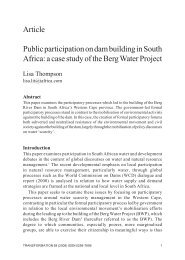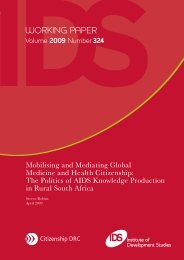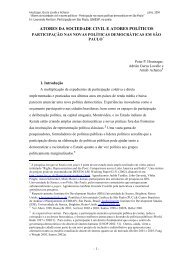Associations and the Exercise of Democratic ... - Citizenship DRC
Associations and the Exercise of Democratic ... - Citizenship DRC
Associations and the Exercise of Democratic ... - Citizenship DRC
You also want an ePaper? Increase the reach of your titles
YUMPU automatically turns print PDFs into web optimized ePapers that Google loves.
IDS WORKING PAPER 2855.2 Socio-economic stratification <strong>of</strong> active citizenshipThe probit models tell us that associational participation, education, <strong>and</strong> someaspects <strong>of</strong> labour market insertion are very likely to influence active citizenship,mobilising government, <strong>and</strong> direct civil relations. These three factors are <strong>of</strong> course notdistributed r<strong>and</strong>omly across <strong>the</strong> population in <strong>the</strong> cities. The socio-economiccomposition <strong>of</strong> <strong>the</strong> population in São Paulo <strong>and</strong> Mexico City raise two importantquestions. First, who <strong>the</strong>n is more likely to be an active citizen in each <strong>of</strong> <strong>the</strong>cities? And secondly, to what extent is socio-economic stratification reflected inactive citizenship? We answer <strong>the</strong>se questions by converting <strong>the</strong> probit modelcoefficients into <strong>the</strong> probability that a citizen with a particular set <strong>of</strong> characteristics,for example low education <strong>and</strong> associational participation, will be active or havedirect civil relations to government in each <strong>of</strong> <strong>the</strong> cities. 41 Tables 5.1 <strong>and</strong> 5.2 describe<strong>the</strong> predictions for each city.In São Paulo <strong>the</strong> probabilities reveal more clearly <strong>the</strong> importance <strong>of</strong> associationalparticipation, as well as <strong>the</strong> powerful impact socio-economic stratification has onactive citizenship. We find that individuals who participate in associations are twiceas likely to be active citizens as those without such participation, <strong>and</strong> that only thosewith associational participation are statistically likely to have <strong>the</strong> desirable direct civilrelations to government (Table 5.1). Individuals without associational participationhave such a low likelihood <strong>of</strong> having direct relations that it is statistically close tozero. Individuals with primary education or less, we estimate, are far less likely tobe active citizens than <strong>the</strong>ir counterparts with higher education, <strong>and</strong> very unlikelyto have direct relations. That is, only 20 per cent <strong>of</strong> those with primary educationor less, a fifth <strong>of</strong> <strong>the</strong> city’s population, are likely to be active <strong>and</strong> statistically <strong>the</strong>likelihood <strong>of</strong> direct relations is almost zero. In contrast, 53 per cent <strong>of</strong> people withhigher education are active <strong>and</strong> 21 per cent have direct relations. Education<strong>the</strong>refore is likely to have a particularly large influence on direct civil relations.The picture in Mexico City is different. Associational participation <strong>and</strong> education alsoinfluence <strong>the</strong> likelihood <strong>of</strong> active citizenship, but not nearly as much as in São Paulo.Table 5.2 shows that in Mexico City 78 per cent <strong>of</strong> individuals who participate inassociations are likely to be active citizens, whereas 46.4 per cent <strong>of</strong> individualswithout participation are active. The gap between those with <strong>and</strong> withoutassociational participation is <strong>the</strong>refore proportionally smaller than in São Paulo. Wedo not have a model for direct relations in Mexico City. Table 5.2 also reveals that72.3 per cent <strong>of</strong> people with some higher education <strong>and</strong> 53.1 per cent <strong>of</strong> thosewith secondary education or less are active citizens. Again, education-basedstratification exists but it is far less than in São Paulo. We noted earlier on that inMexico City <strong>the</strong>re is no statistically significant difference in active citizenshipbetween people with primary education or less <strong>and</strong> those with some secondaryeducation.41 We average <strong>the</strong> predictions generated by <strong>the</strong> models described in Tables B.1 <strong>and</strong> B.2 overindividual’s specific characteristics. For example, <strong>the</strong> proclivity for each individual withassociational participation is <strong>the</strong> predicted probability value; <strong>the</strong> average is obtained from<strong>the</strong>se values for those with such participation.34





